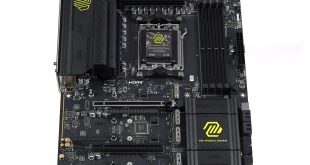Automatic CPU Overclocking:
Selecting the Turbo 4.4GHz mode took our CPU to a 44x divider in seconds. The overclock was perfectly stable and ASRock's voltage settings were close to what we would manually input for this particular chip. We were impressed by this fact, as many ‘automated' overclocking configurations use voltage levels that are much higher than what is required for a given frequency.
Neither the 4.8GHz nor 4.6GHz Turbo mode would boot with stability, but this isn't surprising as we know that this retail 4770K chip is very reluctant to go past 4.5GHz.
Manual CPU Overclocking:
The ASRock Extreme9/ac motherboard had no problems taking our Core i7 4770K processor to its safe limit of 4.5GHz. We used a CPU VCore of 1.350V (which is more than 4.5GHz requires, but it removes frequency limits for further overclocking attempts), a CPU Cache setting of 39x at 1.300V, and a CPU Input voltage of 1.900V. Level 1 LLC ensured that our configured voltages remained constant, irrelevant of load conditions.
Despite opting for the ‘override' voltage mode, we had to manually input the voltage offset to its minimum level to stop the ASRock Z87 Extreme9/ac needlessly adding more than 300mV to our desired level. This is certainly something to watch out for, as our chip's temperatures sky-rocketed when it hit the near-damaging level of 1.430V after we configured it for less than 1.380V.
We were able to hit 4.6GHz using a VCore of 1.375V, but this configuration resulted in unsafe temperatures of 94°C under Prime95 load. We opted for 4.5GHz as our stable overclock that tests would be completed on.
Our 4.5GHz frequency validation can be viewed here.
Memory Overclocking:
While a system's maximum memory frequency may be heavily swayed by the CPU's individual memory controller, the motherboard's performance can also help to obtain higher speeds, especially when XMP settings are taken into account.
We switched to our 2933MHz set of G.Skill Trident X F3-2933C12D-8GTXDG memory to test the Extreme9/ac motherboard's memory overclocking potential. These sticks feature an XMP profile for 2933MHz, although we've yet to test a board at KitGuru that will boot with the XMP settings.
To eliminate memory frequency bottlenecks, we used our overclocked CPU configuration from above, which featured increased voltages for the CPU VCore, CPU Cache, and CPU Input, as well as ASRock's automatic System Agent Offset of +0.204V, according to CPUID HWMonitor. The CPU multiplier was dropped to 40x, representing near-stock levels.
ASRock's Z87 Extreme9/ac is the first motherboard that we have tested at KitGuru which has successfully posted and booted with the G.Skill memory utilising its XMP settings.
Our validation with the G.Skill Trident X F3-2933C12D-8GTXDG memory running at its XMP settings with overclock CPU and motherboard parameters can be viewed here.
Our validation with the G.Skill Trident X F3-2933C12D-8GTXDG memory running at its XMP settings with ‘stock' CPU and motherboard parameters can be viewed here.
The board was also able to boot the memory's XMP settings while all of the CPU parameters and voltages were left at ASRock's ‘stock' settings.
We were very impressed by the Extreme9/ac motherboard's ability to boot successfully with such high speed memory.
After loosening the timings to 13-15-15-35-2T, we tried to overclock the memory a little further using a mixture of the 3000MHz divider, an increased base clock and the 2933MHz divider, and a 125MHz base clock (from the 1.25x BCLK multiplier) and the divider necessary for 3000MHz, but none of them would boot with stability.
We did manage to post and boot at 3000MHz, but only one of the sticks was running with stability, hence we registered the overclock as a failure.
 KitGuru KitGuru.net – Tech News | Hardware News | Hardware Reviews | IOS | Mobile | Gaming | Graphics Cards
KitGuru KitGuru.net – Tech News | Hardware News | Hardware Reviews | IOS | Mobile | Gaming | Graphics Cards


















excellent review Luke. ive been looking at a few of their boards recently and they seem to be improving their bioses in the last year. good looking board too.
excellent review Luke. ive been looking at a few of their boards recently and they seem to be improving their bioses in the last year. good looking board too.
What is their warranty like in Germany? I tend to stick with gigabyte as its very good here locally.
how much that montherboard
I ‘ve got one of these bad boys and the first impression that falls into my mind is this:
BADASS…!!! It worths every Euro i paid…
Excellent review as always…
Greetings from Greece…!!!
Nice review but you miss one important point about the exclusive DP-In (the gamer alternative to Virtu MVP).
With all these trends in modern technology and robotics,
it is starting to be a probability that many of us might soon become enslaved by it most especially if you recognize that there’s nothing
we all do at this time that does not involve modern technology
Hi Luke Hill. Need to see the main.jpg picture of the Z87 Extreme9/ac motherboard’s UEFI BIOS main page. I’m wondering which bios version is that. I’ve tried all versions found in the net and none can get me to set PCI’s other than PCI2 to gen1. Thanks.